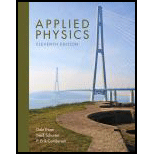
Applied Physics (11th Edition)
11th Edition
ISBN: 9780134159386
Author: Dale Ewen, Neill Schurter, Erik Gundersen
Publisher: PEARSON
expand_more
expand_more
format_list_bulleted
Concept explainers
Textbook Question
Chapter 21, Problem 14RQ
Snell's law involves
a. the lens equation.
b. the index of refraction
c. the focal length.
d. none of the above.
Expert Solution & Answer
Want to see the full answer?
Check out a sample textbook solution
Chapter 21 Solutions
Applied Physics (11th Edition)
Ch. 21.5 - Given so = 1.65 cm and st = 6.00 cm, find f.Ch. 21.5 - Given f = 15.0 cm and st = 3.00 cm, find so.Ch. 21.5 - Given st = 14.5 cm and f = 10.0 cm, find so.Ch. 21.5 - Given st = - 10.0 cm and f = - 5.00 cm, find so.Ch. 21.5 - Given so = 7.35 cm and st = 17.0 cm, find f.Ch. 21.5 - Given ht = 2.75 cm, ho = 4.50 cm, and st = 6.00...Ch. 21.5 - Given ho = 12.0 cm, st = 13.0 cm, and so = 25.0...Ch. 21.5 - Given ht = 3.50 cm. hs = 2.50 cm, and st = 15.5...Ch. 21.5 - If an object is 2.50 m tall and 8.60 m from a...Ch. 21.5 - An object 30.0 cm tall is located 10.5 cm from a...
Ch. 21.5 - Prob. 11PCh. 21.5 - An object 12 6 cm in front of a convex mirror...Ch. 21.5 - What is the height of an image in a truck mirror...Ch. 21.5 - A lift truck has a rear view mirror that is 0.76 m...Ch. 21.5 - Find the focal length of a convex mirror that...Ch. 21.5 - Find the focal length of a mirror that forms an...Ch. 21.5 - Find the focal length of a mirror that forms an...Ch. 21.5 - An image of a statue appears to be 11.5 cm behind...Ch. 21.5 - (a) What is the height of a figurine 7.33 cm in...Ch. 21.10 - Find the index of refraction of a medium for which...Ch. 21.10 - Prob. 2PCh. 21.10 - If the index of refraction of a liquid is 1.50,...Ch. 21.10 - The angle of incidence of light passing from air...Ch. 21.10 - If the critical angle of a liquid is 42.4, find...Ch. 21.10 - If the index of refraction of a substance is 2.45,...Ch. 21.10 - A converging lens has a focal length of 15.0 cm....Ch. 21.10 - An object 2.50 cm tall is placed 20.0 cm from a...Ch. 21.10 - The focal length of a lens is 5.00 cm. How far...Ch. 21.10 - If the distance from the lens in your eye to the...Ch. 21.10 - An object 5.00 cm tall is placed 15.0 cm from a...Ch. 21.10 - An object 4.50 cm tall is placed 18.0 cm from a...Ch. 21.10 - What are the size and location of an image...Ch. 21.10 - What are the size and location of an image...Ch. 21.10 - What is the focal length of a convex lens that...Ch. 21 - Stained glass is an example of a. a transparent...Ch. 21 - A virtual image may be a. larger than the object....Ch. 21 - A real image may be a. erect. b. shown on a...Ch. 21 - Explain the difference between diffusion and...Ch. 21 - Prob. 5RQCh. 21 - Prob. 6RQCh. 21 - Describe the type of images formed by plane...Ch. 21 - Explain the difference between real and virtual...Ch. 21 - Explain the difference between a concave and a...Ch. 21 - Explain the effect of spherical aberration.Ch. 21 - For a mirror of given focal length, how does the...Ch. 21 - For a given object distance from a mirror, how...Ch. 21 - The index of refraction depends on a. the focal...Ch. 21 - Snell's law involves a. the lens equation. b. the...Ch. 21 - Prob. 15RQCh. 21 - Give several examples of total internal...Ch. 21 - Prob. 17RQCh. 21 - Prob. 18RQCh. 21 - Prob. 19RQCh. 21 - What types of images are formed by diverging...Ch. 21 - What types of images are formed by converging...Ch. 21 - How do water waves affect the escape of light from...Ch. 21 - Explain why a fish under water appears to be at a...Ch. 21 - Does light always travel in a straight line?...Ch. 21 - Explain how total internal reflection allows light...Ch. 21 - Under what conditions will a converging lens form...Ch. 21 - Under what conditions will a converging lens form...Ch. 21 - Under what conditions will a diverging lens form a...Ch. 21 - Using 1f=1s0+1si, s0 = 3.50 cm, and si = 7.25 cm,...Ch. 21 - Using 1f=1s0+1si, s0 = 8.50 cm, and f = 25.0 cm,...Ch. 21 - Using M=hih0=sis0, h0 = 6.50 cm, si = 7.50 cm, and...Ch. 21 - If an object is 3.75 m tall and 7.35 m from a...Ch. 21 - An object 43.0 cm tall is located 23.4 cm from a...Ch. 21 - Prob. 6RPCh. 21 - The angle of incidence of light passing from air...Ch. 21 - If the index of refraction of a liquid is 1.44,...Ch. 21 - If the critical angle of a liquid is 45.6, find...Ch. 21 - If the index of refraction of a substance is 1.50,...Ch. 21 - A converging lens has a focal length of 12.0 cm....Ch. 21 - An object 4.50 cm tall is placed 20.0 cm from a...Ch. 21 - The focal length of a lens is 4.00 cm. How far...Ch. 21 - What is the focal length of a convex lens that...Ch. 21 - What is the focal length of a mirror that forms an...Ch. 21 - What are the size and location of an image...Ch. 21 - What is the speed of light passing through a...Ch. 21 - Prob. 18RPCh. 21 - Find the focal length of a concave mirror with an...Ch. 21 - Prob. 20RPCh. 21 - Tamera uses a concave mirror when applying makeup....Ch. 21 - A convex security mirror has a radius of curvature...Ch. 21 - Prob. 3ACCh. 21 - Diamonds are cut to take advantage of internal...Ch. 21 - A photographer uses a 60.0-mm lens. (a) How far...
Additional Science Textbook Solutions
Find more solutions based on key concepts
3. What is free-fall, and why does it make you weightless? Briefly describe why astronauts are weightless in th...
The Cosmic Perspective (8th Edition)
15. In the Olympic shotput event, an athlete throws the shot with an initial speed of 12.0 m/s at a 40.0° angle...
Physics for Scientists and Engineers: A Strategic Approach with Modern Physics (4th Edition)
Use Newton's second law and the definition of acceleration to derive an equation for each cart relating the net...
Tutorials in Introductory Physics
37.71 An airplane has a length of 60 m when measured at rest. When the airplane is moving at 180 m/s (400 mph) ...
University Physics (14th Edition)
For a solid, we also define the linear thermal expansion coefficient, a, as the fractional increase in length p...
An Introduction to Thermal Physics
The speed of the person sitting on the chair relative to the chair and relative to Earth.
Conceptual Physics (12th Edition)
Knowledge Booster
Learn more about
Need a deep-dive on the concept behind this application? Look no further. Learn more about this topic, physics and related others by exploring similar questions and additional content below.Similar questions
- . A small object is placed to the left of a convex lens and on its optical axis. The object is 30 cm from the lens, which has a focal length of 10 cm. Determine the location of the image formed by the lens. Describe the image.arrow_forwardSome telephoto cameras use a mirror rather than a lens. What radius of curvature mirror is needed to replace a 800 mm focal length telephoto lens?arrow_forwardConsider a spherical concave mirror with the object located to the left of the mirror beyond the focal point. Using ray diagrams, show that the image moves to the left as the object approaches the focal point.arrow_forward
- A dentist uses a spherical mirror to examine a tooth. The tooth is 1.00 cm in front of the mirror, and the image is formed 10.0 cm behind the mirror. Determine (a) the mirrors radius of curvature and (b) the magnification of the image.arrow_forwardA ray of light is incident on a flat surface of a Mock of crown glass that is surrounded by water. The angle of refraction is 19.6. Find the angle of reflection.arrow_forwardUnder what circumstances will an image be located at the local point of a lens or mirror?arrow_forward
- A virtual image is formed 20.0 cm from a concave mirror having a radius of curvature of 40.0 cm. (a) Find the position of the object. (b) What is the magnification of the mirror?arrow_forwardCan you see a virtual image? Can you photograph one? Can one be projected onto a screen with additional lenses or mirrors? Explain your responses.arrow_forwardConstruct ray diagrams to determine whether each of the following statement is true (T) or false (F). (a) For an object at a concave mirrors center of curvature, the image is real and inverted. (b) As an object approaches the focal point of a concave mirror, the image size shrinks to zero. (c) For an object in front of a convex mirror, the image is always virtual and upright.arrow_forward
arrow_back_ios
arrow_forward_ios
Recommended textbooks for you
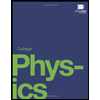 College PhysicsPhysicsISBN:9781938168000Author:Paul Peter Urone, Roger HinrichsPublisher:OpenStax College
College PhysicsPhysicsISBN:9781938168000Author:Paul Peter Urone, Roger HinrichsPublisher:OpenStax College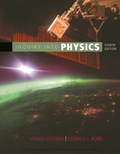
 Physics for Scientists and Engineers, Technology ...PhysicsISBN:9781305116399Author:Raymond A. Serway, John W. JewettPublisher:Cengage Learning
Physics for Scientists and Engineers, Technology ...PhysicsISBN:9781305116399Author:Raymond A. Serway, John W. JewettPublisher:Cengage Learning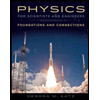 Physics for Scientists and Engineers: Foundations...PhysicsISBN:9781133939146Author:Katz, Debora M.Publisher:Cengage Learning
Physics for Scientists and Engineers: Foundations...PhysicsISBN:9781133939146Author:Katz, Debora M.Publisher:Cengage Learning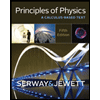 Principles of Physics: A Calculus-Based TextPhysicsISBN:9781133104261Author:Raymond A. Serway, John W. JewettPublisher:Cengage Learning
Principles of Physics: A Calculus-Based TextPhysicsISBN:9781133104261Author:Raymond A. Serway, John W. JewettPublisher:Cengage Learning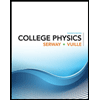 College PhysicsPhysicsISBN:9781305952300Author:Raymond A. Serway, Chris VuillePublisher:Cengage Learning
College PhysicsPhysicsISBN:9781305952300Author:Raymond A. Serway, Chris VuillePublisher:Cengage Learning

College Physics
Physics
ISBN:9781938168000
Author:Paul Peter Urone, Roger Hinrichs
Publisher:OpenStax College


Physics for Scientists and Engineers, Technology ...
Physics
ISBN:9781305116399
Author:Raymond A. Serway, John W. Jewett
Publisher:Cengage Learning

Physics for Scientists and Engineers: Foundations...
Physics
ISBN:9781133939146
Author:Katz, Debora M.
Publisher:Cengage Learning

Principles of Physics: A Calculus-Based Text
Physics
ISBN:9781133104261
Author:Raymond A. Serway, John W. Jewett
Publisher:Cengage Learning

College Physics
Physics
ISBN:9781305952300
Author:Raymond A. Serway, Chris Vuille
Publisher:Cengage Learning
Convex and Concave Lenses; Author: Manocha Academy;https://www.youtube.com/watch?v=CJ6aB5ULqa0;License: Standard YouTube License, CC-BY